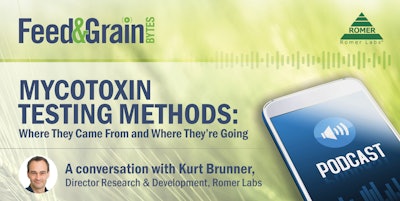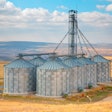
The latest Feed&Grain BYTES features a conversation with Dr. Kurt Brunner, director of research & development at Romer Labs. Listen as we talk about the history of mycotoxin testing methods and what's trending for the future.
Sponsored by:
_NEW.jpg?auto=format%2Ccompress&fit=max&q=70&w=400)
Lisa Cleaver:I'd like to welcome everyone to our latestFeed & Grain BYTESpodcast. I’m Lisa Cleaver with Feed & Grain magazine, and today we have Dr. Kurt Brunner, director of research and development with Romer Labs, here with us to discuss “Mycotoxin Testing Methods: Where They Came From and Where They’re Going.” Welcome, Kurt!
Dr. Brunner:Hello!
Cleaver: So, let’s begin. Can you give us some background information about mycotoxins and how testing for mycotoxins started?
Dr. Brunner:Mycotoxins are a topic with a long history. While the effects of mycotoxins on living organisms didn’t become a huge focus until a couple of decades ago, these undesired fungal compounds have been present in our food for many centuries.
One frequently recurring outbreak among many in history was what became known as St. Anthony’s Fire in the Middle Ages. St. Anthony’s Fire was caused by the long-term consumption of cereals contaminated with ergot alkaloids. Back then, people did not understand what was causing the symptoms they were observing.
Fast forward several centuries later, to the 20thcentury. In an area near London, hundreds of thousands of turkeys suddenly died in 1960. For lack of a better name for this mystery disease, scientists called it Turkey X Disease and started to dig around for what might have caused it, using analytical tools that those in the Middle Ages obviously didn’t have at their disposal. It didn’t take them long to identify a harmful substance produced by a fungus in the peanut meal the turkeys were fed. They discovered that the peanut meal glowed when exposed to UV light. Upon further investigation, they discovered that the meal was contaminated with a fungus called Aspergillus; the glowing material was what came to be known as aflatoxin.
The term “mycotoxin” was born and aflatoxin attracted the interest of many scientists around the world. Nowadays, this incident is considered to be the birth of modern mycotoxin research, including the development of suitable analytical methods to detect those compounds at an earlier stage to avoid similar damage to humans and animals.
Cleaver: What did this first generation of analytical methods look like?
Dr. Brunner:Thin layer chromatography (TLC) was the most popular method for aflatoxin analysis in the 60s and 70s. It allowed for the screening of large numbers of samples in an efficient and affordable manner. This method was optimized over many years to detect other groups of mycotoxins as well. It began as a qualitative method – meaning it gave a simple yes/no answer about the presence of the target mycotoxin – but was later optimized to produce semi-quantitative results. Although TLC was a pretty simple method, it required highly purified samples to work properly. As the most common samples were different types of cereals, these early analysts had to carry out very complex sample preparation methods followed by a proper clean-up. All-in-all, it was a pretty cumbersome process.
Beginning in the 1970s, the popularity of TLC decreased as more versatile, robust and accurate options for mycotoxin analysis became commercially available.
Cleaver: What was the next big thing after thin layer chromatography?
Dr. Brunner:高效液相色谱法,即HPLC, became a well-accepted analytical method in the early 1970s and began to be used for mycotoxin analysis in the second half of that decade. It still required quite a lot of sample preparation, but less than the old TLC methods. While you still needed skilled personnel and a well-equipped environment to carry out HPLC, more & more labs were able to do it. Furthermore, the accuracy of HPLC could not be matched by other methods – and it is still the method of choice if you need highly accurate results. The numbers show this development clearly: in 1978, TLC was used to analyze around 90% of all corn and peanut samples in the US for aflatoxins; a decade later, TLC was used in only around 40% of these samples. Most were analyzed with HPLC.
It’s important here to clear up a common fallacy about methods for mycotoxin detection. We tend to think of mass spectrometry as the most recent and most advanced method for mycotoxin measurement. This is not 100% true: the first publication applying HPLC for aflatoxin detection already used a mass spectrometer as a detector.
The 70s and 80s actually mark the beginning of approaches, popular nowadays, that rely on highly sophisticated instrumentation like mass specs. With the development of ever better, more sensitive and more robust instruments, the results got better and better. From year to year, lower and lower amounts of mycotoxins could be detected. This was a real eye-opener: it was obvious that mycotoxins occur much more frequently than we had ever expected; we just didn’t have the right tools to see them all. HPLC accounted for 80% of all applied analysis methods for corn and peanuts by 2002. By then, TLC had almost completely disappeared.
The turn of the millennium also marked two crucial developments in the evolution of mycotoxin analysis methods: the rise of mass spectrometry and the growing need to analyze for several mycotoxins at once. Mass spec was – and still is – an expensive method. One mass spectrometer was (and still is) as expensive as almost 10 standard HPLC instruments. At the time, it was little more than a complicated niche application. It was by far not as accurate as well optimized HPLC approaches. But there was one fact that helped mass spectrometry win the race: it was capable of analyzing numerous toxins in just one single run, meaning it was an extremely versatile system.
This was in answer to an emerging need: more and more mycotoxins were falling under regulation in the different countries and measuring them all with HPLC became increasingly cumbersome as it is not really suitable for multi-mycotoxin measurements. The first mass spectrometry multi-mycotoxin methods combined just a few toxins, but soon the number of compounds able to be analyzed in just one run increased dramatically: by 2006, that number was at 39. (This was a milestone publication: no other paper on mass spec mycotoxin analysis has been cited more often!) Four years later, mass spec was able to analyze for several hundreds; nowadays, we’ve surpassed more than 1000 substances, including mycotoxins, other biotoxins, and pesticides. However, this particular race is more of academic interest, as industry is mainly concerned with regulated toxins.
As advances were made in multi-mycotoxin methods, the instruments themselves became much more powerful: modern mass spectrometers are several degrees of magnitude more sensitive than the instruments used in the early 2000s.
Nowadays, multi-mycotoxin methods are offered by most service labs as they provide a good balance of accuracy and analysis time for several toxins, amounting to very reasonable costs per sample.
However, modern instruments are a bit like race cars: their performance is impressive, but they need experts to be run properly and they are made for a well-equipped laboratory environment only. Over time, the basic simplicity of TLC was forgotten, and concepts like analysis in simple factory labs or even on-site analysis were clearly not possible with the new analytical methods.
Cleaver:So, let’s shift a bit away from the analytical lab to the field. How or when did today’s on-site test systems emerge?
Dr. Brunner:Interestingly, the first immunoassays grew up right along with emerging HPLC methods. It seems that, from the beginning, scientists were looking for some balance: on the one hand, there was a drive to greater accuracy. As instruments became more accurate, they also grew more sophisticated and complicated. On the other hand, we see a need to keep it simple: user-friendly approaches with an acceptable degree of accuracy appeared on the market: antibody-based ELISA tests. This built on a technology already known; so-called immunoassays were discovered in the early 1960s and worked based on the interaction of antibodies with a specific antigen.
This means that while Turkey X Disease was raging in the UK, the theoretical knowledge about antibodies was already available, but it wasn’t until 1977 that the first antibodies against aflatoxins were raised.
真菌毒素非常小分子和生产antibodies against such compounds is really challenging. Almost immediately after the first aflatoxin antibody had been created, the first aflatoxin ELISA was presented to the scientific community. It did not take long until more and more ELISAs were developed against an increasing number of mycotoxins.
At the same time, the sensitivity and accuracy of these systems improved rapidly. Nevertheless, they were still mainly for research applications. The companies that are well-known these days for offering mycotoxin ELISA test kits did not exist back then. Commercial kits didn’t become available until the 1980s.
ELISA kits had several practical advantages. They allowed for operation in a minimal laboratory setting. The only instrument you absolutely needed was a plate reader, which is cheap compared to the instruments I’ve discussed up to now. A laboratory technician with minimal training on the product could easily run the tests. Additionally, the throughput of ELISA is remarkable, as many samples can be analyzed in parallel. Nevertheless, the whole workflow required quite several pipetting steps and the whole system could not be transferred to real on-site locations such as testing for acceptance at grain elevators or at a factory entrance.
It wasn’t until lateral flow devices emerged in the mid-2000s that mycotoxin testing truly went on-site. Just as with other methods, these LFDs, or strip tests, as they’re known, were first created to test for aflatoxins; other analytes soon followed.
At the beginning, tests were merely qualitative, giving only a yes or no answer. However, as regulatory limits were introduced, a simple yes/no was no longer sufficient and tests with certain cut-off levels were introduced. Those cut-off levels were usually well aligned with regulations in the US and the EU. The big advantage of those cut-off strips was that absolutely no equipment was needed. They could be read with the naked eye and samples could be classified easily as either above or below the chosen cut-off level. These strips are still in use in niche markets as their simplicity is still unparalleled.
Around 2010, LFD strips became quantitative in format, which was a big leap forward. Yet there was a catch: to quantify the result, a reader was needed. These readers are generally pretty simple instruments offered at very reasonable prices and feature a simple user interface. Quantitative strip tests do not require any specific study or professional background; anyone can use them after a short training. Nowadays, quantitative LFD tests deliver high-quality results, and their quality is subject to certification by different regulatory bodies such as the USDA-FGIS (formerly GIPSA), which is extremely demanding regarding accuracy and robustness of the system.
Cleaver: So that brings us up to the present. One current topic in mycotoxin analysis is what some call a competition between the lab-based methods and the immunoassays. Of the immunoassays, some even refer to a competition between ELISA and LFD. What’s your take on this concept of competition?
Dr. Brunner:在最近的一次。这实际上是描述的很好publication from the National Reference Laboratory for mycotoxins in Belgium: they see it as less of a competition than an increasing demand for both, or, as they put it, “increasingly rapid and simple methods AND … more reliable reference methods”. I think that this describes the current situation accurately. These analytical approaches are not in competition but are rather complementary. Mass spec methods are for those who need highly accurate results documented on a report from an ISO 17025-certified laboratory (but let’s not forget: the costs still need to be reasonable and the lab needs to turn results around fast!). ELISA and LFD kits are for those who need quick results, can’t send their sample away and need to keep their costs down. Nevertheless, these kits must still deliver good results.
And even the two immunoassays, ELISA and LFD, are not really in competition. If many samples need to be analyzed in parallel, ELISA is still a very good option. If you only have a few minutes to analyze samples, and if these samples come in sequentially, one after another, then the strip test is the method of choice.
Furthermore, the more laborious ELISA procedure provides you more options to adapt the method to complex or uncommon samples that, for whatever reason, can’t be easily analyzed with strips. Each test system has its particular use case where it performs best because it is just the most suitable solution.
Despite this, and I hope I’m not contradicting myself too much, I have observed a growing trend toward LFD tests, especially since their quantification capabilities and reliability have increased tremendously over the last decade. Ultimately, people have simply learned to trust the new technology.
Cleaver: As our talk comes to a close, let’s glimpse into the future of strip tests. What can we expect next, now that the accuracy and reliability of LFDs is more or less established.
Dr. Brunner:Yes, it is true that the LFDs have come a long way: from merely qualitative to semi-quantitative with a cut-off level, to fully quantitative now. But this journey is far from over. Continuous improvement will further increase the analytical performance of the strips. Think of this as an evolution that will likely continue as long as LFDs are around.
As I see it, the next revolution will occur somewhere else: usability. The heart of LFDs always was and still is this: “easy to use everywhere you need to use them”. Everyone should be able to use them, regardless of the environment – you should be able to carry out your analysis wherever you need it. Simplicity was the basic idea of LFDs, and they will only grow simpler to use even as they maintain high standards of accuracy.
Let’s explore this idea of simplicity a bit by looking at the reader that allows for quantitative results. The newest generation of LFD readers will take user-based errors out of the equation by taking over a lot of the tasks that users previously had to do. Readers will “see” the inserted strip and automatically know the toxin that is being analyzed, suggest common matrices, time the incubation of the strip and so on. Technologies proven to make life easier in other applications will be integrated, such as touchscreens that guide the user through the workflow.
The bottom line is this: the LFD, a method known for its rapidity will become even more rapid. Hands-on time will be reduced and more analyses can be run in parallel without sacrificing accuracy. Romer Labs, I’m proud to say, will be launching a new system within the next few months that brings even greater speed, accuracy and usability to the strip test. Perhaps we can come back toFeed & Grainto talk more specifically about this when the time is right.
Cleaver:Well, that's all we have time for today. Dr. Brunner, I'd like to thank you for joining us and discussing mycotoxins, and I'd like to thank all of you for listening. For more information, click the link below. Thanks!
For more information, visitromerlabs.com.


















